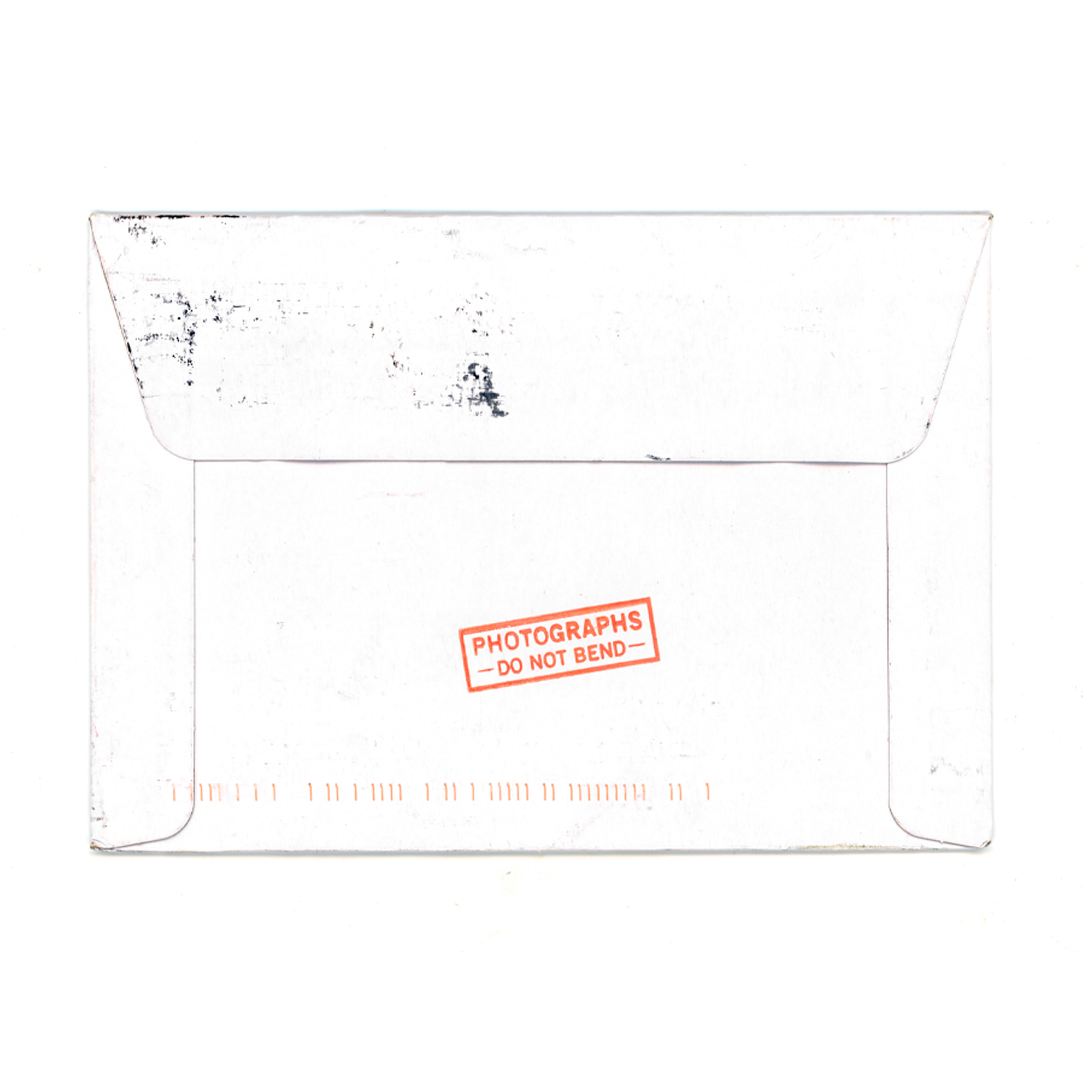



Photographs - Do Not Bend -
On my way out the door, I open up the mailbox. Among the notices and adverts is an anonymous small white cardboard envelope. I briefly inspect it before slipping it into the bottom of my bag. When I get home after my day, I remind myself to finally see what’s inside. It’s from Orlando, Florida and to be honest, I’ve actually forgotten what I purchased. But with careful hands, I open the envelope to reveal the contents, which includes only a single Polaroid photograph, two old postcards (to protect it) and a thank you note from the seller. 
The photograph:
A boy about 14 years old stands in a room with a very bright turquoise t-shirt. On his right arm is an ink drawing of what appears to be a human with very large feet.There is something comical in his pose. The combination of showing off the ink drawing as if it were a real tattoo, combined with the awkward expression you always see in these early teenage photos. A comfortable awkwardness. Actually, the image isn’t particularly interesting at all, it’s probably just another photograph for some sort of collection that will never see the light of day.
Ironically, something else catches my attention instead. On the back of the envelope is written in red lettering from a stamp: PHOTOGRAPHS – DO NOT BEND – . These simple words have a strange effect on me. They stick in my mind for several days and I can’t bring myself to throw the envelope in the bin, even though it’s essentially useless now.
Something makes it impossible not to dwell on the words, which strangely enough seems to hold a deeper wisdom that extends beyond the practical instruction to avoid physically bending the photograph. A completely routine stamp has somehow captured the very essence of photography for me.
This instruction becomes a symbolic reminder that memories, dreams and moments are fragile by nature, yet indestructible.
Given the modern processing of parcels and mail, it’s poetic to think of my little envelope as a protector of dreams, personal memories and alternate realities. In the midst of a hectic world of conveyer belts and automated sorting systems, the envelope is a timeless reminder of the personal and the present. It holds a photograph, not just as a stand-alone image, but instead as an idea, a portal to a forgotten past. A past that I now place myself in direct connection with. 
I pick up the photograph again and perceive it in a new light. Perhaps it is the very quietude of images that can make them so immediately compelling. It takes no more than four simple words to send me into a kind of frenzy. In fact, these images don’t require words, timestamps or notes to tell their story. They let me, the viewer, do the work instead. As I continue my examination of the photograph, I realise that maybe the charm of it lies in the unimposing, subtle colours, expressions, and details. Perhaps, it’s yet another little reminder that most stories often unfold in the unassuming corners of our lives, just waiting for someone to take notice and breathe life into them.
I believe that behind every single image ever produced, there is a tiny mystery, a story waiting to be interpreted. It can be large or small. Old flames, familial joys, lost friendships, or moments of indescribable beauty. A creased edge, faded corners, or a lingering basement odour is a trace of another person’s lived life. Small, quiet lives that stretch out into the infinity of time, making us think, feel and connect in a way that goes beyond just the physical object and the obvious nature of the medium.
I think the fascination with these forgotten stories comes from the ability to actually bend the time of a photograph in the imagination, even though the envelope specifically tells us not to. The direct connection to the past opens a door to a parallel world where the linear nature of time simply ceases to exist. Imagining a reality that has no concrete answers, in a society that constantly pushes forward and seeks a meaning in everything.
Although time relentlessly passes, we still possess the power to reconstruct and relive moments in our own minds. Whether it is that of a loved one or a complete stranger that lived across the globe. Perhaps that’s why I’m constantly searching for these lost stories. They not only represent the past, but also a unique power in our ability to imagine a reality without the before-mentioned clear answers and meaning. Photographs become almost lucid in their silence. All it takes is a simple observation to set the mind in motion. There is a certain magic in letting the mind wander freely, allowing stories and ideas to form organically without being guided by any predefined paths. 
This journey through time, images and memories is about realising that some stories don’t need a conclusion. I believe that images are at their best in the silent and unspoken, and that this is where their true beauty and depth lies. Despite the directions on the envelope, I would argue that photographs, in fact, should and always will bend. In the quiet spaces where stories remain untethered, photographs submit to the relentless flow of time, embracing the unspoken, while retaining the timeless allure connecting one generation to the next.
Yet, as I hold this photograph in my hands one last time, I can’t help but wonder about a future where tangible memories, like this one, have become no more than just relics of the past. In a time of cloud storage and social media feeds, the tactile connection to moments may reduce, being replaced only by the glow of the screens on all our devices.
One day, there will be no more envelopes with red-lettered instructions left. The last physical image or album has been sold. No more flipping through these albums, while feeling the weight of time physically in your hands. Instead, our entire lives may be desiccated into pixels, cataloged in algorithmic archives of forgotten/lost social media profiles. Different interesting layers will emerge, waiting to be excavated.
But for now, I will hold onto my envelope and my Polaroid, recognising them as a testament to the power of the physical, the tangible, and the silent stories. In a world where photographs may no longer bend in our hands, the narratives they carry will always continue to develop in the limitless spaces of imagination, connecting us and surpassing the limitations of time.
Literature: 
Barthes, R., Camera Lucida, Vintage, 1993.
Sontag, S., On Photography, Penguin, 2019.
Sandbye, M., Kedelige Billeder: Fotografiets Snapshotæstetik, Politisk revy, 2007.
Malcolm, J., Still Pictures: On Photography and Memory, Granta, 2023.
Batchen, G., ‘Snapshots’, Photographies, vol. 1, no. 2, 2008.
Cross, K., ‘The Lost of Found Photography’, Photographies, vol. 8, no. 1, 2015.